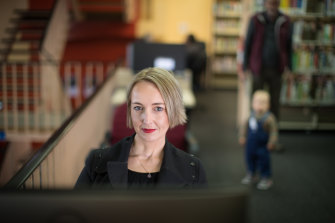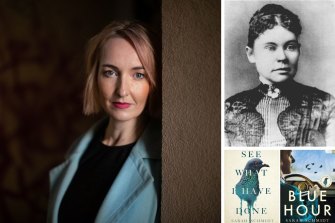
The librarian often used to hear from readers that they wanted a book that didn’t make them feel uncomfortable. What did that mean, she wondered. Didn’t they want to read about confronting subjects?
Yet the best stories often make readers uncomfortable. “I see the role of fiction when it’s sometimes dark is to help readers understand or experience something through the safety of a book,” she says.
The librarian is award-winning author Sarah Schmidt, and hordes of her readers in Australia, Britain and the US share her view of dark fiction. See What I Have Done, her 2017 debut novel, was an international sensation. It reimagined the true story of Lizzie Borden, accused of murdering her parents with an axe. That story began with a dream in which Lizzie sat on the author’s bed and began to tell her story.

Sarah Schmidt at Ivanhoe Library, one of three she embraced when she moved to the suburbs. Credit:Simon Schluter
Schmidt’s second novel, Blue Hour, also began with a dream. We talk about it over coffee in a Brunswick cafe near her home. She has relieved the Melbourne black uniform with a confident combination of rosy hair, red shoes and a bright blue coat. A long time ago, her book tells us, humans didn’t have a word for the colour blue.
In her dream, a sad and angry young woman was driving towards blue mountains. She kept looking in the rearview mirror, and Schmidt wondered what she was looking at, so she looked too, and discovered the woman’s baby daughter in the back seat. Then Schmidt woke, and discovered she was having a miscarriage.
This was one of a series of miscarriages when Schmidt was trying to have a baby with her then partner. She was also wrestling with ambivalent feelings. “Every time I had a miscarriage I just kept thinking, maybe motherhood is not for me. It started bringing up feelings about my own parents.” Finally she went to an IVF clinic, where the doctor told her she had “two really big eggs” and that she should try again. She did, and gave birth to Alice, now 10.
As it turned out, Alice is a happy and loved child. But Schmidt struggled with anxiety that she might repeat her own experience of being parented. She remembers taking baby Alice for a walk on a cold morning, when an older woman came up to her. “She touched me on the shoulder and said ‘I know what it’s like, I thought about killing my son as well’.” Schmidt had never had such a thought, but the woman’s words stuck with her. “Birth is a wonderful thing, but it makes connections and raises memories you haven’t even thought of.”
A few years later, See What I Have Done came out: “That was the best and worst time in my life. It was great to have this achievement. But in the meantime I was starting to have a breakdown for a whole raft of reasons.” It all came to a head when she went on her own to the US for a book tour. “I was remembering my own childhood and realising I couldn’t be in the relationship I was in any more — we had grown apart.
“Almost every night, I wanted to die. I’d had depression and anxiety before but I’d never felt that way.” She began to realise she needed to write about her feelings and memories. “I wanted to be open about things, but how far could I go?”

Sarah Schmidt’s first novel followed a dream about Lizzie Borden.Credit:Simon Schluter
The result is Blue Hour, at its heart a mother-daughter story about Eleanor, the young mother driving into the mountains in her dream, and her mother, Kitty, and their fraught relationship. Reading it is not so much uncomfortable as gut-wrenching, but in a good way. “I want people to walk away from the book having a true feeling about something,” Schmidt says. “It’s my complete and entire life. It’s also nothing to do with my life.”
She set her story in the 1970s, with chapters from Kitty’s point of view going back to the 1940s, which gave her “the illusion of distance” from her own memories. Kitty was her favourite character: “She’s awful; I don’t like her. But I loved writing her.”
While Kitty is not her own mother, there are parallels. “My mother was abused as a child by a family member, and I knew about it from a young age.” There was no discussion, no therapy, no attempt to remove the sense of shame. As many children do, she felt responsible and tried to stop her mother from feeling sad. “You can spend your entire life trying to make someone happy — you feel that’s your job.”
Another thing that Schmidt knew from a young age was that her mother had tried to kill her. “She told me many times, how she stopped it from happening. She had these overwhelming feelings and thoughts. She really struggled to talk about it. But at the same time, she told me everything.
“I love my mother. I have many happy memories of my childhood. I never felt unloved. But she was depressed.” Her husband was often away in the navy, and she gave birth at just 19. “I wish I could have hugged her and told her everything was okay, but that’s a lot to process. She wanted to communicate something a lot of women don’t ever talk about. It’s just unfortunate that when I first heard it, I was too young.”
Loading
In her book, Kitty is grieving for different reasons, and becomes bitter, even savage. Poor young Eleanor has an extra burden placed on her. “I made a rule to myself that Kitty was never to tell Eleanor out loud that she loved her,” Schmidt says. “That helped to shape a different sense, a more complex trauma of someone feeling they are not loved.”
Schmidt is adamant that this is not an anti-mother book. “It can be a very dark time in people’s lives ... I wanted to show that side of motherhood. If people read it and feel connected, I would be happy that’s a shared feeling. I want people to feel they’re not alone.”
TAKE 7: AUTHOR SARAH SCHMIDT
- Worst habit? There are many but let’s go with a tendency to overthink and over-analyse most things.
- Greatest fear? Reaching the end of my life and dying with regrets.
- The line that stayed with you? I know this should probably be something relating to literature but the first thing that popped into my head was something that was said to me in a traumatic situation a few years ago. But that needs to stay in the past. Instead, the best line from life that stays with me is when my daughter was very young learning sentences and told me, ‘You make my heart.’
- Biggest regret? Just one?! I think it’s probably not being as brave as I should’ve been at certain points of my life.
- Favourite room? Any room where I’m alone, writing or thinking about writing, and an idea decides to visit and stay with me instead of someone else on its journey.
- The artwork/song you wish was yours? All Is Full of Love by Bjork. Everything about it is gold.
- If you could solve one thing? The crisis of capitalism! But also on my list: who killed the Bordens. I was hoping I’d have more insight when I was with Lizzie all those years ago for See What I Have Done, but she gave me nothing. I just want to know.
Through her time settings, Schmidt was also able to explore the damage done to men returning from war. George, Kitty’s husband, is “horribly hurt inside and outside” from his World War II days: he wears a facial prosthetic and has PTSD nightmares. Eleanor’s husband, Leon, already a violent man, returns from Vietnam even more fearsome.
In writing Leon, Schmidt could draw on another dark experience: “I was raped and strangled in my sleep.” She had allowed a visitor from overseas to sleep on her couch. “He acted like nothing had happened the next day and I thought, you’ve done this before.”
For a long time she could not bear to tell anyone about it, not even her therapist. But one day when she heard people at work talking about rape, she picked up a stapler and threw it across the room. Then she told her manager. “That was the beginning of becoming more comfortable and telling people what had happened.”
‘I realised there was nothing wrong with me.’
Writing Leon felt necessary, but was awful. “Every time I got into that headspace I was traumatised.” She would start her writing day with the recall of a memory she was going to borrow from her own life and “allow myself to sit in that feeling… the more I let myself open up, the more I connected with my characters and what they needed. It was very liberating, very cathartic. But there was this huge downside because you’re sitting with trauma all the time.”
Loading
Her therapist asked her why she was doing this to herself. Because she had to, she said. “It had never occurred to me that at the end of the day I could check in with myself and say, ‘I’m Sarah, I’m this person, I’m not that person’. You have got to be kind to yourself.”
After four years of writing, she handed a huge manuscript to her publishers: “It was 270,000 words, it was out of control. Paragraphs weren’t even finished. I didn’t know what was wrong with me.” Working first with Robert Watkins (who later left Hachette for Ultimo Press), and then with Vanessa Radnidge, she refined the sprawling text to focus on the mother-daughter story.
Today, Schmidt says she thinks of Blue Hour as a love letter to her daughter. It was a love that didn’t come immediately at birth. “Weeks went by. I thought there was something broken inside me. Then one day a crow flew above her and she had a big smile on her face. I felt like I’d lifted up outside of my body and I could see the world for what it really was: human and nature and love and all of those big things.
“I thought, that’s what love is. I realised there was nothing wrong with me. I think I was falling in love with my daughter at that moment.”
Blue Hour by Sarah Schmidt (Hachette), is out June 29.
Support is available from Beyond Blue on 1300 22 4636 and Lifeline on 13 11 14.
The Booklist is a weekly newsletter for book lovers from books editor Jason Steger. Get it delivered every Friday.









 Add Category
Add Category